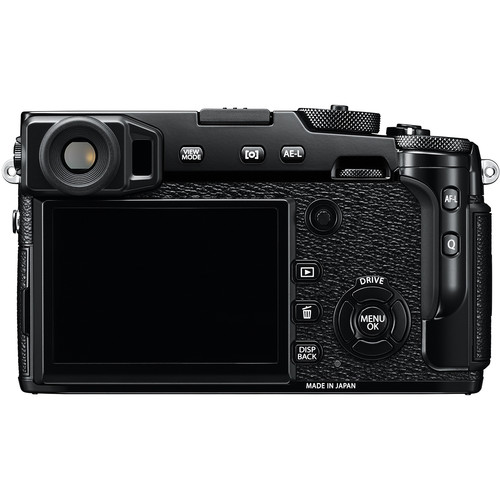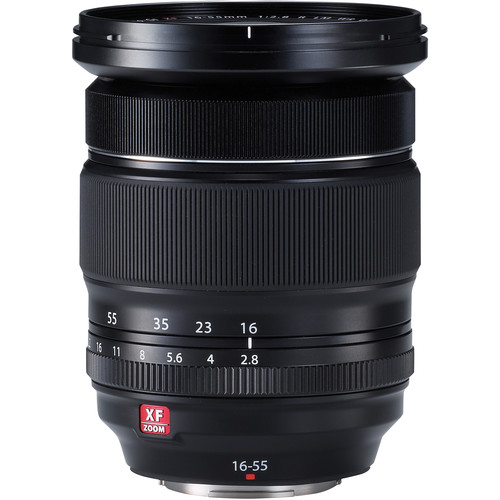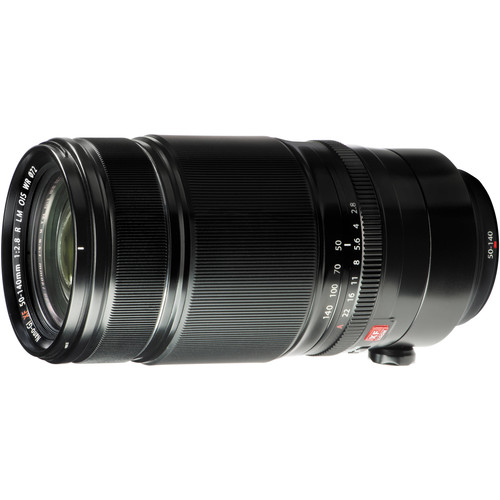
Fujifilm XF 50-140mm f/2.8 R LM OIS WR Lens
People often ask me what lens is my “if I could only have one lens” lens for my DSLR and without hesitation I always say my 70-200mm f/2.8. It does matter if I shoot with Canon, Nikon, Sony or any other camera platform – it’s the 70-200mm f/2.8 that I love the most. When I talk to fellow pro photographers and enthusiasts it’s very common for me to hear others say the same thing.
As the mirrorless format has taken off, it’s quite common to hear people saying they are retiring their DSLR’s in favor of the more compact and lighter weight mirrorless systems like the Fujifilm X Series (i.e., X-T1, X-E2, X-Pro1, X-M1, X-A1, etc…). This begged the question, then what about your most popular lens? Until recently there was no equivalent, so those who have chosen to go with Fujifilm X-Series cameras have been thrilled at the arrival of the Fujifilm XF 50-140mm f/2.8 R LM OIS WR Lens – a fixed f/2.8 aperture equivalent coming at 35mm equivalent of 76-213mm.
This is lens that feels in the hand that it is built by Zeiss. While it appears to be all metal, the zoom ring is actually rubber which does have a tendency to be a dirt magnet. However, it feels fantastic in the hand and operates very smoothly. Everything about this lens screams quality so it’s big price tag will be easier to swallow when you hold it in your hand and think that for this price you can only get a constant f/4 for your DSLR body.
With a lens so big on a camera designed to be compact really be worth it? Read on to find out how it compares and my thoughts.
It should be noted that I tested this lens for this review with my own X-E2 using the v3.0 firmware. I set NR (noise reduction) to –2 and had OIS on for everything except long exposure shots (e.g., Bookshelf images).
Excellent OIS (Optical Image Stabilization)*
During my testing I found the OIS (optical image stabilization) of this lens to be outstanding. Even in cases where I was at 140mm and shutter speeds as low as 1/10 sec I was able to get a reasonably sharp shot of a stationary object. Please keep in mind that OIS only stabilizes camera shake so if your subject is moving then you may need faster shutter speeds than the OIS minimums to freeze your subject.

X-E2, f/2.8 @ 140 mm, 1/10, ISO 400, No Flash (Handheld)
Notice At 213mm (35mm Equivalent) the rule of thumb says that I'd need a minimum of 1/213 sec to reduce natural camera shake to get a steady shot, but the optical image stabilization (OIS) was so good I was able to do 1/10 of a second!

Unedited in-camera JPEG 100% zoom of focus point from the shot above
Notice the dust fiber on the bottom left grab handle and the thumb print detail
Please note that the subject was not moving so this is only possible with stationary objects and your results may vary depending on your physical ability to hold a camera still.

OIS is NOT Tripod Aware
OIS Off (left) OIS On (right)
I also observed that OIS is NOT tripod aware on this lens, so if you take a long exposure shot on a tripod you’ll want to manually turn it off otherwise you’ll get a blurry shot even of stationary objects.
Heavy, but hey it’s a constant f/2.8!

Overhead - Canon 5D Mark III w/ 70-200 f/2.8 IS II vs X-E2 w/ 50-140
The compact advantage starts to dwindle with this lens
At 2.19lb (995 g), this is a very heavy lens for a mirrorless camera. My X-E2 only weighs 12.35 oz (350 g) with battery and memory card and even the X-T1 only weighs 15.52 oz (440 g). By comparison, most of the Fujifilm lens I’ve tested have weighed roughly less than the camera body itself so this is a pretty heavy lens for this type of camera. With that said, it is still a little over 1 pound lighter than my Canon 70-200mm f/2.8L IS II USM, but it is heavier than the popular Canon 70-200mm f/4L IS which only weighs 1.67 lb (760 g). The Nikon equivalents are very similar in weight to the Canon’s, so the same comments apply to Nikon.

Side by side you can better tell the real difference
but the 50-140 is very similar in size to the Canon 70-200mm f/4 IS
Alternatives
If the weight is an issue, you can certainly consider these lenses but personally I’d gladly take the weight for the image quality and fixed f/2.8 that this lens offers. Some people would much rather take a hit in quality for the extended focal range and significantly cost savings, so Fujifilm has done a great job of trying to meet the needs of all its customers by offering these alternatives:
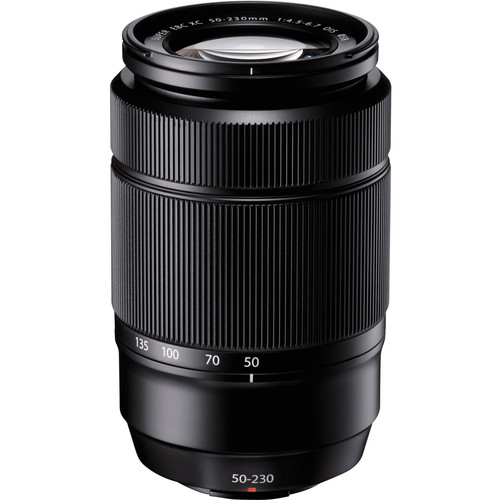
Fujifilm XC 50-230mm f/4.5-6.7 OIS Lens
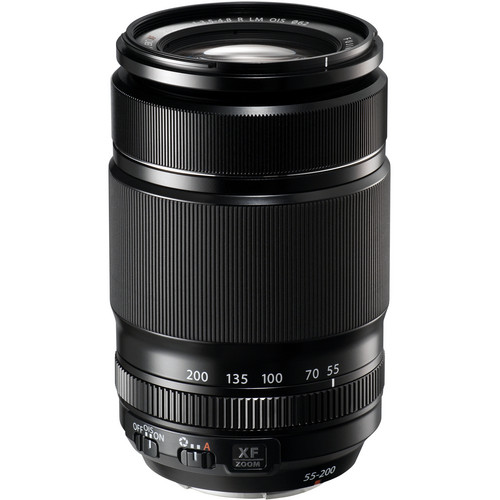
Fujifilm XF 55-200mm f/3.5-4.8 R LM OIS Lens
Noisy Motor
One concerning feature of this lens is the amount of audible noise that comes from it at all times. While it is subtle and not especially distracting, there is a constant noise that comes from it continuously when the camera is not in sleep mode. I could easily notice this noise from the side from up to 3 feet away and nearly 1.5 feet away from behind the camera. My primary concern isn’t so much the noise as it is the amount of battery that must be getting drained when this noise is observed. Turning OIS (Optical Image Stabilization) off made no difference, and at the time of this review there was no firmware update for the lens to address this issue.
Tripod Collar

The tripod foot design is similar enough to share the same foot plate as your DSLR lenses
The tripod collar of this lens is excellent and rotates smoothly with an excellent locking screw. The foot easily accepted my Arca Swiss plate that I use with Canon and Nikon super telephoto lenses. If you have other long lenses you should try your lens plates out before rushing out to buy one specifically for this lens as my experience has determined that it isn’t necessary.
Bookshelf Shots
There 13 in-camera JPEG’s here for your viewing pleasure, but I’ve included a few here. You MUST click each to view them at 100% to really appreciate the images, so the “thumbnails” here are just for reference.
These were all taken with NR –2 and Provia film simulation under conditions identical to all of my bookshelf shots done with other cameras. While the camera and a hot shoe bubble level both indicated that it was level, I think some lens distortion (more noticeable at 50mm) resulted into the angled bookshelf effect that you see below. A general observation of sharpness and bokeh is still possible at the various apertures and focal lengths available in the gallery (most of which aren’t referenced here).

X-E2, f/5.6 @ 50 mm, 5s, ISO 200, No Flash, NR -2, Provia
Right away I was wow’d by the sharpness of the 50mm and the f/5.6 shot above was the sharpest of the bunch. At 140mm you definitely loose some sharpness, but it still performs well and certainly beats the dust collecting hassle of changing prime lenses right?

X-E2, f/5.6 @ 140 mm, 5s, ISO 200, No Flash, NR -2, Provia
In my testing I had to bump my ISO for the f/16 & f/22 shots to avoid going to bulb mode. My testing at ISO 200 validated that this lens does get softer at f/16 & f/22, but it is still sufficiently sharp and very usable. At f/8 to f/2.8 it is razor sharp with the major differences only being depth of field. I was sufficiently impressed and wouldn’t hesitate to use the entire range of this lens as needed to meet my needs on a shoot. I’d probably avoid f/22 unless I really needed it, but I’d feel comfortable doing paid work at f/16.

X-E2, f/4 @ 50 mm, 2.5s, ISO 200, No Flash, NR -2, Provia (OIS OFF)
To my eyes, the super zoom actually felt a little sharper at f/4 than the 56mm prime. Now this makes sense when you consider the range of the prime, but what it means in the real world is that even 56mm prime users may have a reason to put this lens on instead of their prime when shooting at larger f/stop numbers (common under studio lights).

X-E2, f/4 with 56 mm f/1.4, 2.1s, ISO 200, No Flash
See my Fujifilm XF 56mm f/1.2R Review

Canon EOS-1D X, f/8 @ 100 mm, 20s, ISO 100, No Flash
Surprisingly I didn’t have any 70mm bookshelf shots on file so I pulled my 70-200mm at 100mm and f/8 shots that I used for my D4s article. While it’s not scientific by any stretch, you can get a ballpark idea that full frame super DSLR’s are still going to give you the sharpest results, but this lens is no slouch.

X-E2, f/8 @ 50 mm, 10s, ISO 200, No Flash, NR -2, Provia
Nikon and Canon both still have the edge in sharpness, brightness and AF performance this match up, but I’ve never had better real-world stabilization performance than what I saw with the Fujifilm setup.

Nikon D4S, f/8 @ 100 mm, 30s, ISO 100, No Flash
See my D4s Review
Real World Images
Here are some few high ISO images taken indoors under tungsten light conditions. The full gallery can be found at http://photos.ronmartblog.com/lens/fujifilm/50-140mm, and SEE PART II for wildlife shots outdoors.
All of the images for this article were taken with OIS ON and using NR –2 which sets in-camera noise reduction to its minimum setting. Noise reduction still takes place which gives skin a skin softening effect as you’ll notice from these UNEDITED in-camera JPEG images. Most images were taken using the Velvia film simulation mode.
All images are Copyright © Ron Martinsen 2014 – 2015 – ALL RIGHTS RESERVED. You may click the images or visit the gallery to view the full-size in-camera original JPEG’s, but you may modify, edit, print or otherwise use any of these images without my expressed written consent (and yes, this even includes the really bad ones – ha, ha).

Happy New Year from ronmartblog.com!
X-E2, f/2.8 @ 54.1 mm, 1/60, ISO 5000, No Flash, NR -2, Provia

The lower half of the zoom range on this lens is super sharp with great bokeh
X-E2, f/2.8 @ 54.1 mm, 1/42, ISO 6400, No Flash, NR -2, Velvia

I haven’t had a chance to do a model shoot with this lens yet, but this bokeh performance
tells me that I’m going to love the results under studio lights and low ISO
X-E2, f/2.8 @ 140 mm, 1/60, ISO 1250, No Flash, NR -2, Velvia

This is a sharp lens, but it does tend to shoot a little darker
than what I’m used to from my 56mm f/1.2R Prime
X-E2, f/4 @ 54.1 mm, 1/60, ISO 1000, No Flash, NR -2, Velvia

The 1.5x crop factor means more depth of field than what I’m used to from my full frame at f/2.8
I quickly got used to that, and APS-C DSLR shooters will appreciate the similarities
X-E2, f/2.8 @ 56.3 mm, 1/45, ISO 6400, No Flash, NR -2, Velvia

Yes, it is a terrible shot but I was impressed with how sharp the eyes were in this shot
so I felt compelled to include it – especially when you look at the EXIF below!
X-E2, f/2.8 @ 119.2 mm, 1/60, ISO 5000, No Flash, NR -2, Velvia
Here’s a similar shot with the 56mm f/1.2R – not a apples to apples compare, but FYI

Low light forced me to live at f/2.8 but gave me a great appreciate for this lens
X-E2, f/2.8 @ 54.1 mm, 1/40, ISO 6400, No Flash, NR -2, Provia

140mm certainly isn’t as sharp, but it is still quite good with excellent bokeh
X-E2, f/2.8 @ 140 mm, 1/60, ISO 5000, No Flash, NR -2, Provia

I regretted using Velvia film simulation for my test images
as I definitely preferred the Provia colors
X-E2, f/5.6 @ 50 mm, 1/14, ISO 6400, No Flash, NR -2, Provia
As I mentioned at the start of this section, better stuff is coming. My apologies for the placeholder images for now.
Conclusion
Some people will switch to a system like the Fujifilm X Series to reduce their overall load and size requirements of their gear, so they will need all of the lenses that a larger DSLR system provided. In the DSLR world, the 70-200mm f/2.8 is a must have lens for most photographers so it’s great that this system now offers an equivalent. If you fall into this camp then this becomes a must have lens so don’t let the weight throw you.
If you were one of those people who avoided the big 70-200 f/2.8’s in favor of the f/4 then you’ll be surprised to discover that this lens is heavier than what you are used to so that might be concerning for some. The good news is that you are rewarded with a sharp lens with phenomenal stabilization support with good, but not DSLR-like AF performance. What I mean by this is that sports and wildlife shooters aren’t going to be happy, but wedding, event, travel, portrait, etc… shooters will probably find it to be good enough.
Since I personally have no desire to drop my DSLR system in favor of any mirrorless platform (and yes that includes the mighty Sony A7R), I can’t see myself getting such a bulky lens for my “compact” camera system. To me it just defeats the purpose for owning a X series camera.
For those that have a desire to leave the DSLR at home and need this range, then this is a great lens that I highly recommend. For people who have a DSLR with a 70-200mm f/2.8, then I recommend you pull out the DSLR when you need that lens and keep a nice collection of small zooms and primes for your X series camera.
See PART II for more photos.
Where to order
Click here to learn more or order at B&H.
Need a camera bag?

Perception Backpacks
Upgrading lenses to this size often means a new camera bag. I’d strongly recommend you consider the Perception Backpacks or Mirrorless Mover by ThinkTankPhoto.

Inside the Think Tank Photo Mirrorless Mover 30i
Other articles you may enjoy
If you enjoyed this article, you may also enjoy these:
Disclosure
If you make a purchase using links found in this article, I may make a commission. It doesn’t cost you a penny more, but it does help to support future articles like this. B&H loaned the zoom lens in this article this review, but the X-E2 and 56mm used in this article were my personal property that I paid for at full price.
NOTE: This site requires cookies and uses affiliate linking to sites that use cookies.
. Either way, your support is greatly appreciated!
This blog is intended for freelance writing and sharing of opinions and is not a representative of any of the companies whose links are provided on this site.
The opinions provided are of Ron Martinsen alone and do not reflect the view of any other entity
